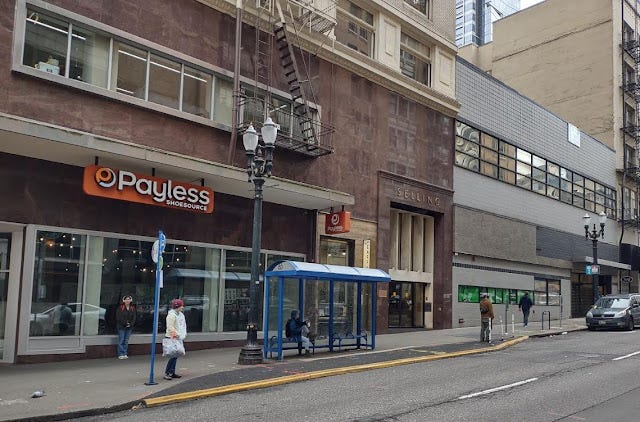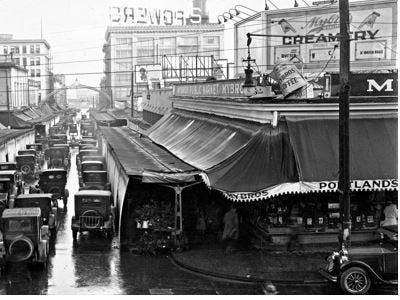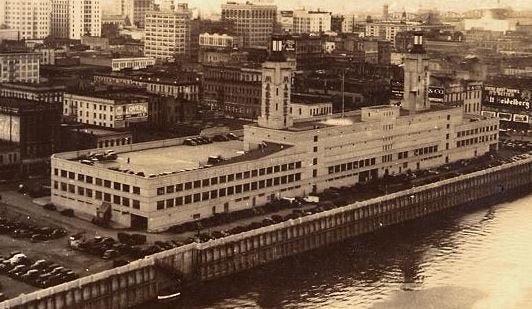Could a new public market survive downtown?
Success of the James Beard Public Market is less than a certainty
Plans are certainly aggressive for a James Beard Public Market that would contain a restaurant, numerous fresh food stalls, a bookstore, cooking classes and an event space in the 600 block of Southwest Alder Street.
The proposed market would use the ground floor of the Selling Building at the corner of Sixth and Alder, and an adjacent two-story building and basement that the market has purchased next door.
A successful new food venue surely would be a big plus for a downtown struggling with far fewer workers and many more shrouded retail windows than it had just a few years ago. But even if the ambitious plans come to pass, will they succeed?
History provides us with some interesting analogs. Long story short: Success is not a slam dunk.
Beard Market supporters mention the wonders of Seattle’s Pike Place Market that has been a fresh food retail paradise—and tourist attraction—since its founding in 1909. Interestingly, a young grocery clerk named Fritz Grubmeyer lived nearby and saw the value of the market from the outset.
The young Grubmeyer later shortened his name to Fred G. Meyer and became one of the primary operators of the Carroll Public Market that on Portland’s Southwest Yamhill Street. Meyer ran some stalls himself under sidewalk tarps and leased stalls to others between SW First and Fifth Avenues. From its beginning in 1914 with the city government’s approval, the market was a success. Alas, the rise of the automobile put increasing pressure on use of Yamhill Street and City Hall came up with a new plan.
The Carroll Public Market closed in 1934, which marked the opening of the huge Portland Public Market building that stretched 600 north and south at the foot of Yamhill Street at Front Street. But four lanes of traffic separated the building from the heart of downtown. Fred Meyer and many other sellers at the Carroll Public Market refused to move to the new building.
Meyer, of course, took his growing business indoors. Over the decades he built a chain of Fred Meyer stores that added clothes and many other retail categories, making it the first “one-stop shopping” complex in the Pacific Northwest before his death in 1978.
Meanwhile, the Portland Public Market limped along for a few years before closing as a failure. The building was leased for military use during part of World War II, and then was sold to become home of the Oregon Journal newspaper for several years. Ironically, the building was purchased by the city government and then demolished in 1969 to help make way for the new Tom McCall Waterfront Park.
[The Yamhill Marketplace opened in the 1980s as an indoor farmers market of sorts and was successful for the first five years until Pioneer Place opened nearby.]
Which brings us full circle. Could the new James Beard Public Market succeed? For the good of downtown Portland, one hopes the answer would be “yes.”
But on the other hand, will many workers be returning downtown when the pandemic has taught them the benefits from working on computers at home? Will many people desire to live downtown when it is less attractive than it used to be? Can the market survive or thrive with competition from seasonal farmers’ markets in the South Park Blocks?
Someday, history will reveal the answers. Plans for the market received major boosts this summer with $12 million in grants and donations, including $10 million from the Oregon Legislature and $1 million from the city of Portland. A firm opening date has yet to be determined.
Join Building on history’s email list by writing “add me” to faroverpar463@gmail.com







I just keep thinking - is there some reason the city refuses to just make public commitment and real policy changes that contribute to public safety/small business success? Most of the things they do (imbedding low barrier shelters in the middle of high density residential/commercial spaces, expanding metered parking times, refusing to change the bottle bill return rules, refusing to enforce time and place camping, etc. etc.) achieve exactly the opposite of bringing people back to the downtown/NW/Pearl core that used to be so thriving. They seem to think just building expensive new venues without addressing the underlying problems is going to be successful and I personally do not think it will be. It’s lazy, it’s tone deaf, and it’s ultimately very irresponsible.
This mayor and city council had a real chance to come in and make things better - there was a lot of “low hanging fruit” that they could have worked to address and would have been known as the group that came in and turned things around. Instead, they have somehow managed to completely fumble this and double down on every bad decision that has led us here. Wilson and the city council are real disappointment so far - if things continue on this path I hope we all wise up and make their tenures short.
I have never believed this new, state legislature-supported Public Market would ever be anything other than another taxpayer boondoggle. It will be too expensive to patronize for anyone but the tourists and will die a lingering death. The governing bodies of Portlandia and Multnomah County are always looking for magic bullets to jump-start our ailing metropolitan area (think professional sports teams, music venues, anything "entertainment"), rather than doing the long hard slog of providing public safety, maintaining functional infrastructure and demonstrating to the citizens that they can be trusted as ethical, responsible adults with their tax resources. Living within our means does not have to look like this, but it does mean some hard choices.
I think that before our hyper-progressive political establishment will be willing to do that, the tax base will have been gutted by many of us moving out.